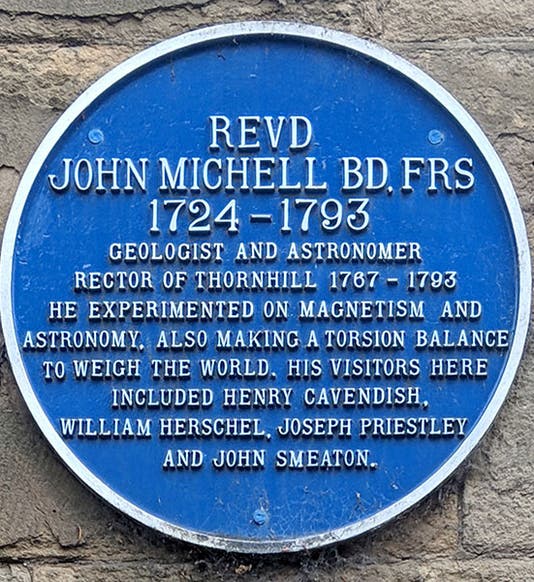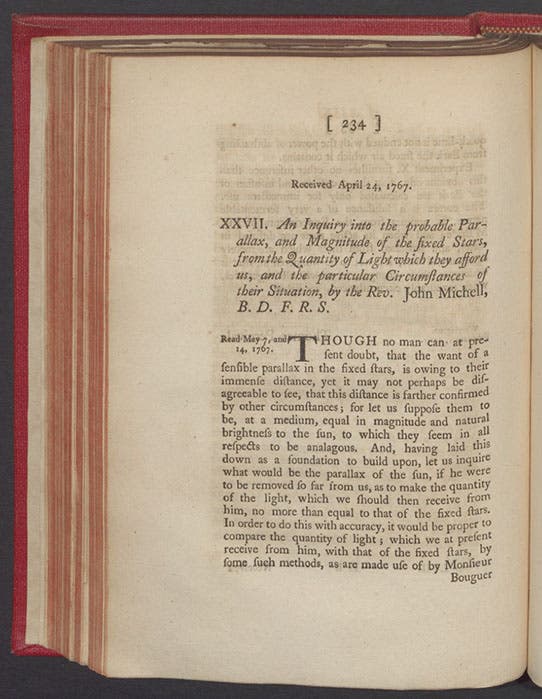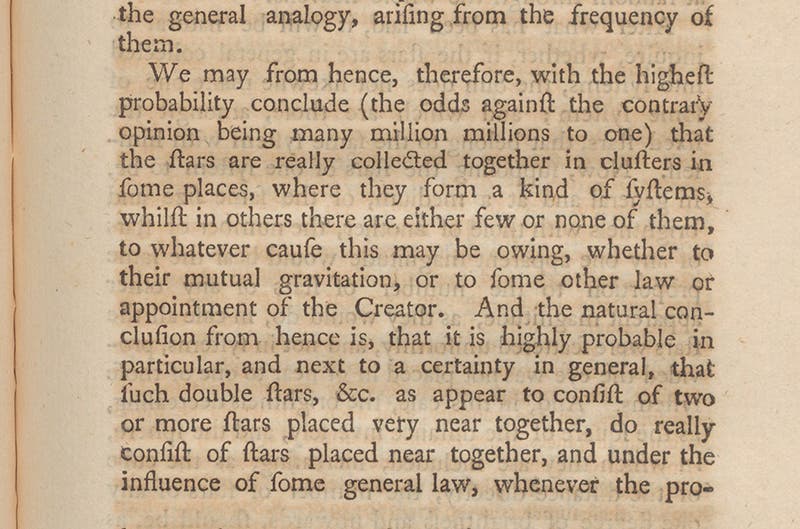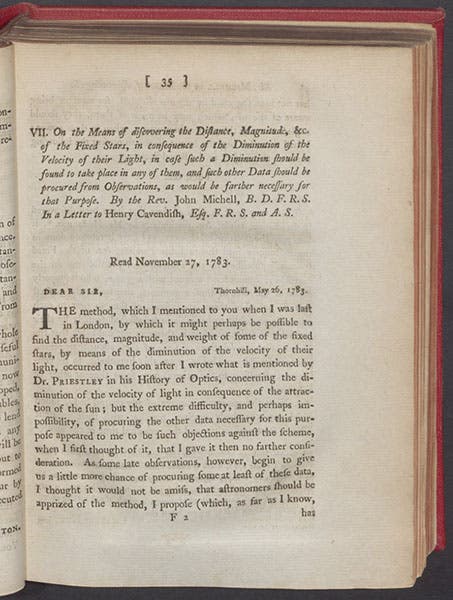Scientist of the Day - John Michell
John Michell, an English physical scientist, died Apr. 21, 1793, at the age of about 69; his birthdate is unknown. Hardly anyone who is not a specialist in the history of science has heard of Michell, and even in his own day, only a few people were aware of his work. After receiving a degree from Queens’ College, Cambridge, he spent 15 more years there as a fellow, and eventually he ended up as rector of the parish church in Thornhill in West Riding, Yorkshire, thanks to the patronage of George Savile, a wealthy landowner and a friend from his college days. We have no portraits of Michell; he wrote just one book, on artificial magnets (1750), and published a few papers in the Philosophical Transactions of the Royal Society of London. And yet it is not unusual today to see Michell described as the most original and far-seeing thinker of the 18th century, after Newton.
Passing over his work on geology and earthquakes, which was fairly well known in his lifetime and was responsible for the modest reputation he did have, we will discuss three of his other achievements, beginning with his proposal for weighing the Earth. Newton's formula for the force of gravitation on Earth has the mass of the Earth as one of its factors, but no one knew what that was, and the equation has one other unknown, the gravitational constant. If one could determine the gravitational constant, then the mass of the Earth would be the only unknown, and could easily be determined. So Michell invented a device, called a torsion balance, for the express purposes of measuring the gravitational attraction between two objects, in this case, two lead spheres. Two lead balls, about 2 ½ lbs each, are affixed to the ends of a short rod, and the rod is balanced and suspended by a fiber from a support. If two other large balls are then brought close to the balls on the rod, they will feel a mutual attraction due to universal gravitation, and the rod will rotate slightly, twisting the fiber. The amount of twist is proportional to the force of attraction, so by measuring the angle of twist, one can determine the force, and hence solve for the gravitational constant, which will ultimately yield the mass of the Earth. The apparatus was extremely sensitive to very small forces (and the gravitational attraction between two spheres is very small indeed), which was why it could succeed where all other apparatus failed.
Michell died before he could perform the experiment, but his apparatus and instructions for its use passed to his friend Henry Cavendish, who performed the experiment successfully in 1798. Cavendish gave full credit to Michell in his paper, but it nevertheless became known as the Cavendish experiment, one of the most famous experiments of the 18th century, and the fact that Michell invented not only the experiment but the apparatus was quickly lost from view. We wrote a post on Cavendish, where you can see his diagram of Michell’s torsion balance.
Earlier, in 1767, having turned to astronomy from geology, Michell published a paper, “An Inquiry into the probable Parallax, and Magnitude of the fixed Stars…,” in which he considered the problem of measuring the distances to stars (second image, above). The accepted method at the time was to look for stellar parallax, a slight deflection of the positions of stars caused by the Earth’s change in position as it orbits the Sun. The angle of parallax, however, was too small to be measured by instruments of the time. In his paper, Michell suggested that we use double stars to determine stellar distance. Most astronomers thought that double stars are really just stars that are physically distant and just happen to line up, only appearing to be neighbors (see detail of the relevant paragraph, third image above). Michell statistically argued that most such stars really are binary stars, in orbit around each other, and he suggested that by measuring their orbits and using Kepler’s period law (which Michell ascribed to Newton), we might be able to calculate masses and, from the apparent brightness, the distances of such stars. It was an ingenious idea.
But it was another paper that is responsible for Michell's sudden prominence these days, since a key observation from this paper was not brought to light until 1979, when it created a sensation (at least in history of astronomy circles). In 1783, Michell read a paper to the Royal Society titled "On the means of discovering the distance, magnitude &c of the fixed stars" (fifth image, just above). It was published the next year. In it, Michell mused on the fact that, since light is a particle and has mass, then light emitted from a star should be dragged back by the pull of gravity and slowed down. Taking the matter further, he wondered if the pull of gravity could ever exceed the escape velocity of the light. Doing some calculating, he concluded that if a star were about 500 times more massive than the Sun, then no light would ever be able to escape. The star would be dark and unobservable to us. Michell had predicted the possible existence of black holes (see the relevant paragraph, below, sixth image). He further pointed out that if another star were orbiting one of these invisible stars, we could learn a lot about the dark star’s mass from the motions of the orbiting star.
It is not surprising that no one noticed this before 1964, when black holes were first described by physicists. It is surprising that it took 15 more years for someone (a historian of science, naturally) to realize that Michell had come up with the idea almost 200 years before post-Einsteinian astrophysicists steeped in general relativity got to thinking about the matter. It was a remarkable intellectual deduction on Michell’s part.
There is not much to show, image-wise, to augment our Michell anniversary, just a blue plaque on the outside of Thornhill Parish Church (first image), the church itself (fourth image), and a memorial plaque near his (unknown) grave in the church (seventh image, below). Since the blue plaque doesn't mention black holes, I had always assumed it was emplaced before 1979, but it turns out it was installed in 2007, so apparently they don’t get too excited about black holes up there in West Riding.
I will relate one final story, the veracity of which I have yet to ascertain. Several recent short biographical accounts of Michell state that on May 23, 1771, Michell hosted a dinner at the rectory in Thornhill; the guests included Joseph Priestley (future discoverer of oxygen, who lived just 15 miles away, in Leeds), Jan Ingenhousz (future discoverer of photosynthesis), and Benjamin Franklin, who was visiting the area, and that furthermore, the group then went, the next morning, to visit another neighbor, John Smeaton, who had built the Eddystone lighthouse. It is further stated that evidence for this remarkable meeting only recently came to light. This may all be true – indeed, I hope it is – but no one cites any sources for either the meeting or the recent discovery of the meeting, and I have been unable to validate it myself. If the verification is out there, I hope someone will send it my way.
Dr. William B. Ashworth, Jr., Consultant for the History of Science, Linda Hall Library and Associate Professor emeritus, Department of History, University of Missouri-Kansas City. Comments or corrections are welcome; please direct to ashworthw@umkc.edu.










![Columbine, hand-colored woodcut, [Gart der Gesundheit], printed by Peter Schoeffer, Mainz, chap. 162, 1485 (Linda Hall Library)](https://assets-us-01.kc-usercontent.com:443/9dd25524-761a-000d-d79f-86a5086d4774/3829b99e-a030-4a36-8bdd-27295454c30c/gart1.jpg?w=210&h=210&auto=format&fit=crop)

